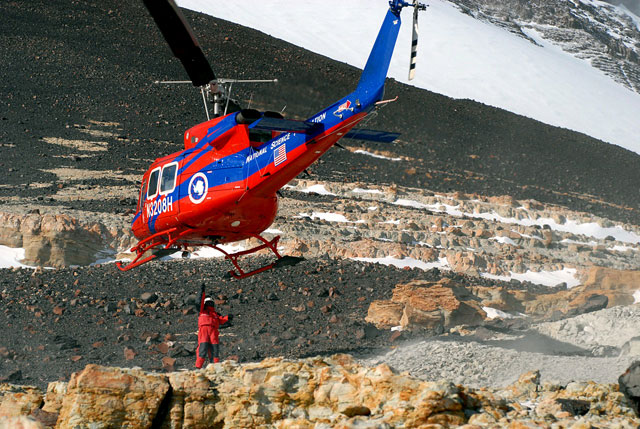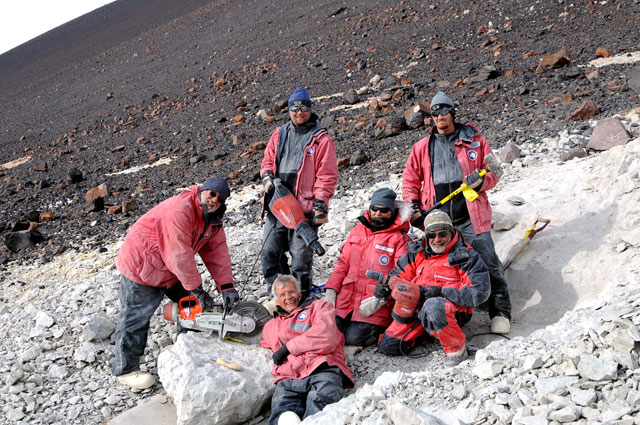|
Page 2/2 - Posted April 15, 2011
Paleontologists race against time to recover 'critical' Antarctic fossilsThat’s in contrast to the Early Jurassic, when the world’s landmasses were sealed together in the supercontinent called Pangaea. “The world was a biogeographic superhighway,” Makovicky said, explaining that an animal could literally traverse from one end of the world to the other. The big question: Did they? Cryolophosaurus’ closest relatives to date lived in what is modern-day United States and China. In the Pangaea configuration, they would have been at the far corners of the supercontinent from Antarctica. On the other hand, another find from the same quarry on Mount Kirkpatrick during the 1990-91 season — described less than four years ago in the online journal Acta Palaeontologica Poloncica — appears to be a more southern-bound species. 
Photo Credit: Peter Rejcek
Field Museum paleontologist Peter Makovicky displays a chunk of rock recovered from Mount Kirkpatrick.
That creature was a massive plant-eating primitive sauropodomorph, which was called Glacialisaurus hammeri. It also lived during the Early Jurassic about 190 million years ago. The description of the dinosaur was based on partial foot, leg and anklebones. Many more bones of the animal were collected during this season. Sauropodomorph dinosaurs were the largest animals to walk the Earth. “That [quarry] keeps producing more and more bones,” Hammer said. However, the field season wasn’t all about dinosaurs this time around. Other members of the team, led by Christian Sidor “We’re trying to do the whole Mesozoic as much as we can,” said Hammer, referring to an era nearly 200 million years long, sandwiched between two mass extinctions, and loosely known as the Age of Dinosaurs. Palynologist Eva Koppelhus, also from the University of Alberta, was brought onboard to help reconstruct the flora of the Early Jurassic, details of which have been sparse until now. Koppelhus collects rock samples from the outcrops that she believes might contain bits of organic plant material, such as pollen or spores. Such paleobotanical investigations can reveal clues about the past climate. “This part of Antarctica has never found to have this kind [of material],” Koppelhus said. 
Photo Credit: Eva Koppelhus
Team mountaineer Peter Braddock attaches a cargo net holding a block of fossil-containing rock to a helicopter.
That’s in contrast to the Triassic, a period before the Jurassic, which has yielded a rich record of ancient flora. “It’s simply two different environments; that is the reason why you can find so much in the Triassic and so little in the Lower Jurassic,” Koppelhus said. The Kirkpatrick dinosaur quarry has proven to be prolific but stubborn to release its treasures. The paleontologists, working in temperatures around minus 30 degrees Celsius, ran as many as five power tools at one time to dig out the fossils, including two electric jackhammer drills, a gasoline-powered jackhammer drill and two rock saws. Bad weather or poor visibility means a day of lost fieldwork because the team uses helicopters to travel to the site from the field camp near the Beardmore Glacier. The cold and altitude are tough on people and equipment. Makovicky said he lost a half-day on the mountain trying to get the jackhammer to start in the extreme cold. He had to use the exhaust from a generator to warm it up. “You’re thinking in ways that you’re not used to when you do fieldwork anywhere else,” he said. It’s a mindset familiar to Hammer, who has made eight trips to Antarctica since the 1970s. The 61-year-old paleontologist mused it could be his last visit, at least to the Beardmore region. “We have to get everything we can out now. There [probably] won’t be another camp here for 10 years at least,” Hammer said. NSF-funded research in this story: William Hammer, Augustana College, Award No. 0837951 Return to CTAM 2010-11 main page. |
"News about the USAP, the Ice, and the People"



For USAP Participants |
For The Public |
For Researchers and EducatorsContact UsNational Science FoundationOffice of Polar Programs Geosciences Directorate 2415 Eisenhower Avenue, Suite W7100 Alexandria, VA 22314 Sign up for the NSF Office of Polar Programs newsletter and events. Feedback Form |


